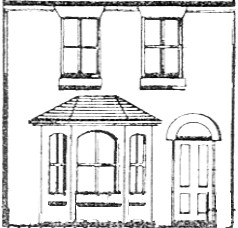Care & Repair
Paint colours and finishes

The Victorian Society Guides
i/ PAINT COLOURS & FINISHES
The Victorian Society is the most authoritative source of historical information on properties of this age.
Is stripped pine an authentic Victorian finish?
The stripped pine look is a late twentieth-century fad: before the 1960s, joinery was painted (or, occasionally, stained to resemble expensive and exotic woods and then varnished). The only exposed pine in a Victorian house was the well-scrubbed top of the kitchen dresser or table. Expensive timber such as solid oak or mahogany was polished or varnished, to enhance its natural beauty and to make it easier to clean.
I like the natural wood look. How can I get that look if I don’t strip the paint off?
Use a woodgrain paint finish. Expensive timbers such as oak, mahogany, rosewood, walnut and ebony can all be convincingly imitated in paint.
Is brilliant white an authentic Victorian colour?
No. ‘Brilliant White’ was not available until after WWII. Choose an off-white or cream colour for a more authentic result.
Is it true that Victorian iron railings were always painted black?
No; various colours have been found on historic ironwork. In the first half of the nineteenth century ‘invisible’ greens (so called because they would blend into a background of foliage) were used for fences, gates, railings and garden furniture. In 1840 Humphrey Repton recommended a ‘bronze’ finish, made by powdering copper or gold dust on a green ground. Green was used throughout the mid Victorian period but dark blue, red and chocolate brown were also popular.
Is it dangerous to keep old paintwork, which may contain lead?
Old lead-based paint is not dangerous unless it is disturbed in such a way as to release the lead into the environment, where it can be ingested, inhaled or absorbed through the skin. Special precautions must therefore be taken during redecorating work, when the old paint is likely to be rubbed down, sanded, burnt off or removed with volatile solvents.
Can I use lead-based paint to redecorate my house?
No. Licences to use paint containing lead are only issued under strict conditions for special historic building renovation projects.
What is distemper?
An inexpensive matt finish, widely used on plaster walls and ceilings, made with whiting (ground chalk) bound with an animal glue size. Cheap and easy to make, distemper dried quickly, could be made in a wide range of colours and could be washed off before each redecoration. It did not trap moisture within the wall, but allowed the structure to ‘breathe’, which made it especially appropriate for newly-built houses
How can I find out what colours were used in the original decoration of my house?
Existing layers of old paint can be examined under a microscope to determine the original colours. However, it takes expert training to be able to analyse the layers, so although a casual scrape with a penknife will give you an idea of the number of paint layers and the range of colours used, it cannot be relied upon to provide an accurate colour sample for a particular date in the past. You would be lucky to find enough old paint samples to provide sufficient information to allow you to recreate an entire decorative scheme, and the cost of professional paint analysis is unlikely to be justified except for conservation of historically significant interiors. The best course is to ‘get your eye in’ by visits to preserved interiors and reading round the subject.
What kind of paint did the Victorians use on the exterior of the house?
On brickwork: nothing. Exposed brickwork should be left bare.
On stucco: some stuccoes are self-coloured and need no paint coat. Lime-based washes in a range of stone colours were used in some cases. Towards the end of the nineteenth century it became fashionable to paint stucco with oil-based gloss paint, especially in towns and cities, where the gloss surface would repel dirt
On render, pargetting, wet dash and pebbledash: lime-based washes.
On exterior joinery: oil-based gloss paint.
















